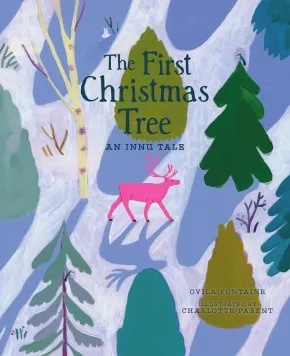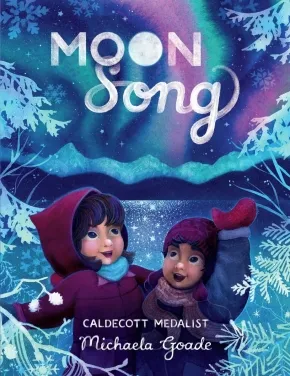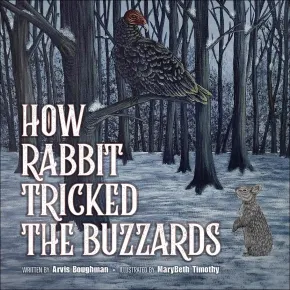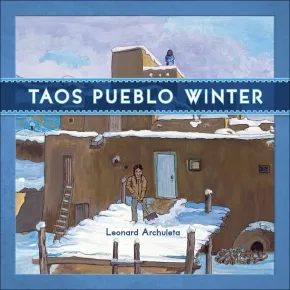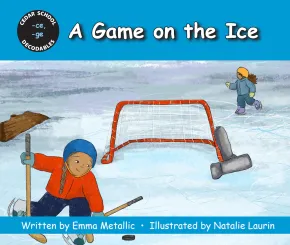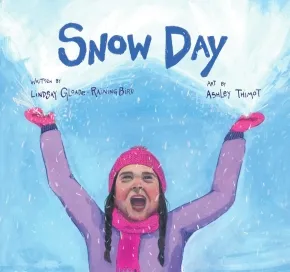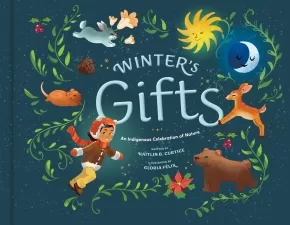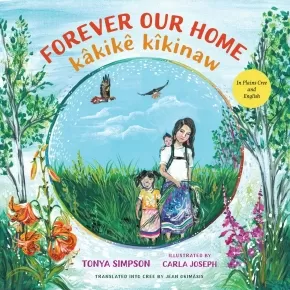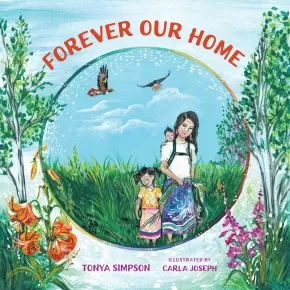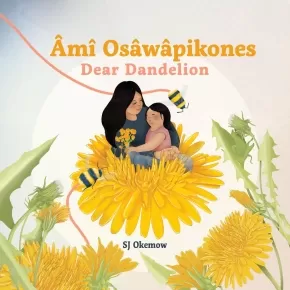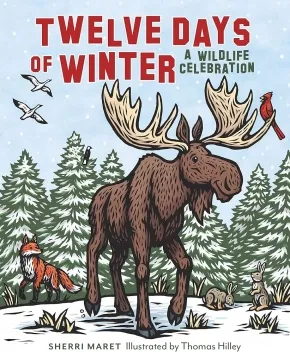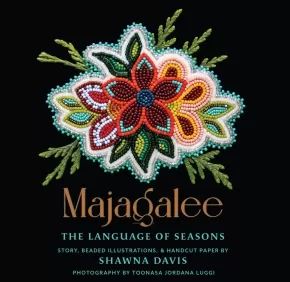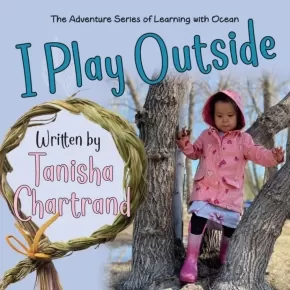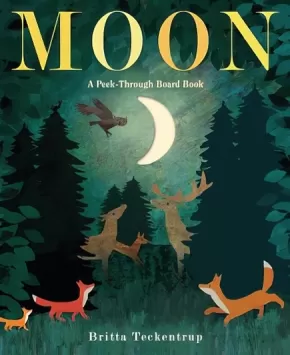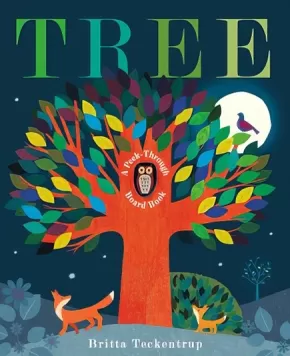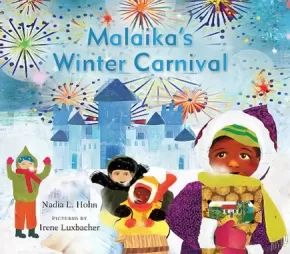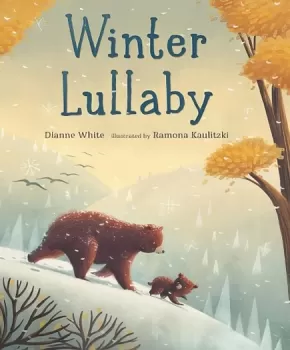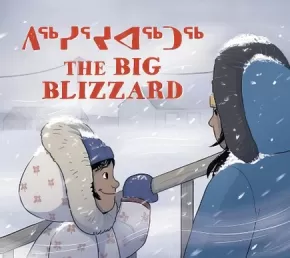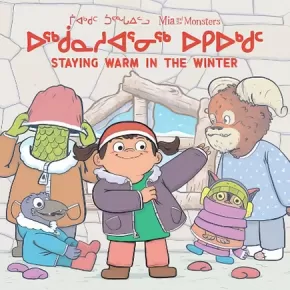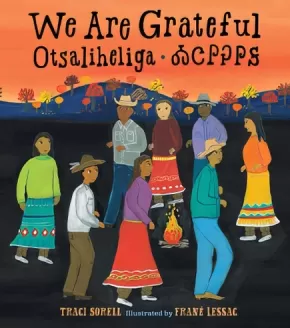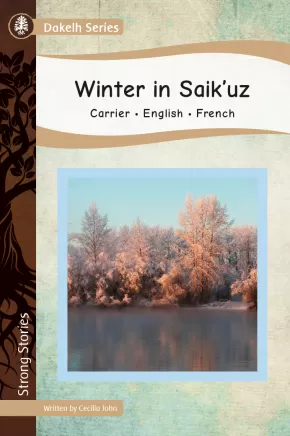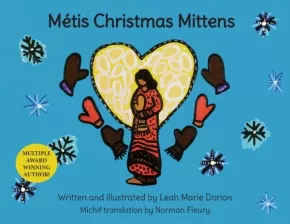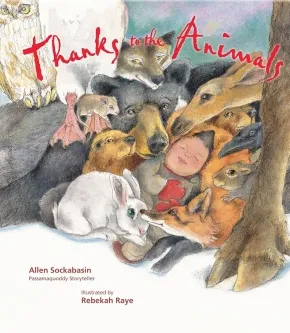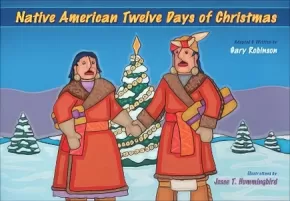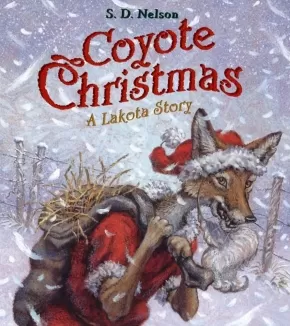
Winter
1
-
15
of
41 Results;
Sort By
Go To
of 3
The First Christmas Tree: An Innu Tale
$24.95
Artists:
Format:
Hardcover
Text Content Territories:
Indigenous Canadian; First Nations; Innu (Montagnais-Naskapi);
Grade Levels: Preschool; Kindergarten;
ISBN / Barcode: 9781459841802
Synopsis:
Synopsis:
It is very cold in the Far North.
The Great Manitou knows that winter is the harshest season for the Innu, and he decides to find a way to make their winters a little brighter. He searches through the trees in the forest to find one who will bring joy, beauty and warmth to all. Could it be the larch, the tree that the Innu use to make sleds, bows or ointments? The birch, malleable and robust? Or the magnificent black spruce? “Do you want to become the Christmas tree?” he asks each one. But one after the other, the trees decline his offer. All except one, the little fir tree, whom the Great Manitou had initially overlooked.
Reviews
“The Great Manitou appears in vibrant fuchsia as various woodland creatures, standing out against the cool winter palette. A Christmas-themed look into Indigenous culture tradition that encourages further exploration.”— School Library Journal (SLJ)
Educator Information
Recommended for ages 3 to 5.
This book is available in French: Le premier arbre de Noël.
Additional Information
56 pages | 8.50" x 10.75" | Hardcover
Umingmak and Fox: Why Is It Dark?
$22.95
Artists:
● Tim Mack
Format:
Hardcover
ISBN / Barcode: 9781774508725
Synopsis:
Synopsis:
A pair of friends, Umingmak and Fox, haven't seen the sun for a long time.
Umingmak the muskox watches the sky growing darker in the winter months. Umingmak is surprised and a little scared! He asks his friend Fox: Why is it dark? Fox explains why it is so dark during the winter and brighter in the summer. Will talking to Fox help Umingmak feel better about his fear of the dark?
Educator & Series Information
Recommended for ages 5 to 8.
This book is part of the Umingmak and Fox series. Umingmak and Fox: Why Is It Dark? takes a playful look at seasons in the North, where winter can be long and dark.
Additional Information
40 pages | 9.00" x 7.50" | Hardcover
Moon Song
$24.99
Artists:
Format:
Hardcover
Text Content Territories:
Indigenous American; Alaska Native; Tlingit;
ISBN / Barcode: 9780316461634
Synopsis:
Synopsis:
Cuddle up with this celebration of winter and explore the wonders of nature’s light with Moon Song from Caldecott Medalist Michaela Goade.
On an island at the edge of a silvery sea, when the moon rises and night falls, a girl spins a story for her worried cousin to help him find comfort in the wintery dark. She invites him to see moonlight glittering in the forest, bioluminescence sparkling by the shore, and northern lights blazing in the sky. In the dark of the night, the whole world sings.
Celebrated Tlingit creator Michaela Goade, who brought us a summer's celebration in the Caldecott Honor Award‑winning Berry Song, invites us to discover the wonder and comfort of a winter's night through a magnificent Moon Song.
Educator Information
Recommended for ages 4 to 8.
Additional Information
40 pages | 9.00" x 11.75" | Hardcover
How Rabbit Tricked the Buzzards
$18.95
Artists:
Format:
Paperback
Text Content Territories:
Indigenous American; Native American; Lumbee;
ISBN / Barcode: 9781570674259
Synopsis:
Synopsis:
Long ago, when the buzzards were keepers of the fire, they were very stingy. On a frigid winter night Rabbit was freezing, he pleaded with the buzzards to share the warmth of their fire. The buzzards refused, yelling "This is our fire!" The playful Northwest Wind saw rabbit hopping slowly away, it decided to play tricks on Rabbit to make him even colder. Rabbit realized that If he wanted to get warm, and share the warmth with the other animals, he must come up with a clever plan.
Educator Information
Recommended for Grades 2 and under.
Additional Information
40 pages | 9.00" x 9.00" | Paperback
Taos Pueblo Winter (BB)
$14.95
Artists:
Format:
Board Book
Text Content Territories:
Indigenous American; Native American; Taos Pueblo;
Grade Levels: Preschool;
ISBN / Barcode: 9781570673450
Synopsis:
Synopsis:
This delightful board book, written without text, was created by the Taos Pueblo's Tiwa Language Program to preserve the Tiwa culture and revitalize the Tiwa language by teaching it to younger generations. Many other Indigenous languages also need revitalizing, so it is the hope of the Taos Pueblo's Tiwa Language Program that other American Indian Nations will find the books in the Toas Pueblo Four Seasons series useful to teach their language to young children. The beautiful, hand-drawn illustrations will also teach young children about the four seasons of the year. All proceeds of the book support the Taos Pueblo's Tiwa Language Program.
This text-free board book allows Indigenous nations to teach their own languages to children.
Educator & Series Information
This wordless book is part of the Taos Pueblo Four Seasons series.
We are the "Red Willow People" of Taos Pueblo and have sustained our ancient village as one of the longest continuously inhabited communities, for over 1,000 years. Taos Pueblo is located in northern New Mexico and our Tiwa language is a dialect of the Tanoan language, which is not a written language. Traditionally we learn our Tiwa Language through oral tradition but we are in danger of losing our ancient language due to colonization, modernization, and the shift from Tiwa as our first language to English as our first language. The efforts of the Taos Pueblo Tiwa Language Program are focused on revitalizing the Tiwa Language and culture by protecting and preserving it, through teaching it to our younger generations.
This text-free board book allows Indigenous nations to teach their own languages to children.
Additional Information
22 pages | 7.90" x 7.90" | Board Book
Cedar School Decodables: Fishing for Smelts
$7.99
Grade Levels: Kindergarten; 1;
ISBN / Barcode: 9781771746472
Synopsis:
Synopsis:
In this story, Log Pond has frozen over, and the class is ice fishing! Bell sings a song for good luck. Will the class catch anything?
Mi’gmaq go ice fishing in the winter. Traditionally, they used sticks as fishing rods.
Have you ever gone ice fishing?
Educator Information
Recommended for ages 4-7, for use in kindergarten and Grade 1 classrooms.
Cedar School Decodables is divided into six sets, which increase in word count and complexity of sentence structure. Fishing for Smelts is in Set 4 – Longer Words, and reviews -es, -ed (/d/, /t/, and /ǝd/), and -ing. Books in Set 4 have 90-100 words.
Readers should be familiar with the concepts included in Set 1 to Set 4:
- consonants
- beginning and end blends
- short and long vowels
- digraphs
- a /o/
- s – /s/ and /z/
- -s, -es, -ed, and -ing suffixes
- VC-CV, V/CV, VC/V, and compound words
- possessives
Series Information
Welcome to Cedar School! Join Liv, Tom, Gus, and Bell as they learn on the land and explore Mi’gmaw teachings with their teacher, Miss Sam, and the school’s Mi’gmaw Elder, Jen. With charming illustrations and simple storylines, this decodable series engages students as they practise their reading skills. Each book includes a pre-reading review of non-decodable words, and many of the books introduce special words related to Indigenous teachings. Talking Together prompts facilitate discussions led by the reading teacher.
Developed in partnership with Dyslexia Canada, Cedar School Decodables is a series of 20 decodable books for young readers. Designed for students who have previously learned short vowel and consonant sounds, additional phonic skills are developed progressively throughout the series.
The series will be accompanied by Cedar School Decodables Teacher’s Guide and a series of four picture books, which will be available at a later date.
Additional Information
16 pages | 6.5” x 5.5” | Paperback | ISBN: 9781771746472
Cedar School Decodables: A Game on the Ice
 $7.99
$7.99

Artists:
Format:
Paperback
Text Content Territories:
Indigenous Canadian; First Nations; Mi'kmaq (Mi'gmaq); Listuguj Mi'gmaq First Nation;
Grade Levels: Kindergarten; 1;
ISBN / Barcode: 9781771746465
Synopsis:
Synopsis:
In this story, Tom and Liv skate on Log Pond. They play a game of hockey!
Mi’gmaq have played hockey for a long time. Early hockey sticks were carved by Mi’gmaq from birch, elm, or ash wood.
What games do you play in the winter?
Educator Information
Recommended for ages 4-7, for use in kindergarten and Grade 1 classrooms.
Cedar School Decodables is divided into six sets, which increase in word count and complexity of sentence structure. A Game on the Ice is in Set 3 – VCe, and reviews -ce and -ge. Books in Set 3 have 80-90 words.
Readers should be familiar with the concepts included in Set 1 to Set 3:
- consonants
- beginning and end blends
- short and long vowels
- digraphs
- a /o/
- s – /s/ and /z/
- -s and -es suffixes
- possessives
Series Information
Welcome to Cedar School! Join Liv, Tom, Gus, and Bell as they learn on the land and explore Mi’gmaw teachings with their teacher, Miss Sam, and the school’s Mi’gmaw Elder, Jen. With charming illustrations and simple storylines, this decodable series engages students as they practise their reading skills. Each book includes a pre-reading review of non-decodable words, and many of the books introduce special words related to Indigenous teachings. Talking Together prompts facilitate discussions led by the reading teacher.
Developed in partnership with Dyslexia Canada, Cedar School Decodables is a series of 20 decodable books for young readers. Designed for students who have previously learned short vowel and consonant sounds, additional phonic skills are developed progressively throughout the series.
The series will be accompanied by Cedar School Decodables Teacher’s Guide and a series of four picture books, which will be available at a later date.
Additional Information
16 pages | 6.5” x 5.5” | Paperback | ISBN: 9781771746465
Snow Day
$24.95
Artists:
Format:
Hardcover
Text Content Territories:
Indigenous Canadian;
ISBN / Barcode: 9781774713112
Synopsis:
Synopsis:
A joyful, rhyming story in the vein of Ezra Jack Keats's The Snowy Day, this debut children's picture book follows an Indigenous family as they enjoy the magic of a winter storm.
All is quiet on the snow-laden street.
Not a single soul makes a teeny-tiny peep.
Then,
With a bound and a bang and a funny kind of twirl
Out comes a bundled-up joyful little girl.
Capturing the magic of a snowfall, Snow Day follows an Indigenous family as they experience all of the delights of a winter's day. While Mom shovels the driveway and Dad cares for her brother by the fire, a young girl and her dog make snowflake tea, build a snow caterpillar, catch snowflakes on their tongues, and make snow angels. All while the snow continues to fall. At the end of the day, the girl is beckoned inside by the promise of hot chocolate, and regails her family with her adventures' and dreams of doing it all again tomorrow.
Atmospheric, nostalgic, and full of winter fun, the debut picture book by mixed-Cree journalist, book reviewer, and podcast host Lindsay Gloade-Raining Bird is a celebration of Indigenous joy and childhood wonder. Features warm, colourful artwork rendered in traditional gouache and coloured pencil from debut illustrator Ashley Thimot.
Educator Information
Recommended for ages 3 to 7.
Additional Information
32 pages | 10.00" x 9.00" | Hardcover
Suupi and the Sun Celebration
$14.95
Artists:
Format:
Paperback
Text Content Territories:
Indigenous Canadian; Inuit;
Grade Levels: Preschool; Kindergarten;
ISBN / Barcode: 9781774506943
Synopsis:
Synopsis:
Join in on the Sun Celebration in Grise Fiord, Nunavut, in this charming bilingual storybook!
Suupi lives in Grise Fiord, Nunavut. After three months of darkness in her community, the sun is finally about to return. Suupi and her friends can’t focus on their schoolwork. Today they will celebrate the return of the sun! There will be a sliding competition, a school performance, and a community feast. But Suupi is nervous about performing with her class in front of so many people. Will she find a way to overcome her fear?
Written by an author from Grise Fiord, a community in Nunavut where the sun doesn’t rise for nine months, Suupi and the Sun Celebration introduces readers to traditions within this Northern community that commemorate the return of the sun each year.
Educator & Series Information
Recommended for ages 3 to 5.
Bilingual Inuktitut and English Edition
Themes: Family, Community, Return of the Sun, Celebrations, Singing, Traditional Songs, Throat Singing, Sun Celebration
This book is part of the Community Connections series.
Additional Information
44 pages | 8.00" x 8.00". Paperback
Winter's Gifts
$20.49
Artists:
Format:
Hardcover
Text Content Territories:
Indigenous American; Native American; Anishinaabeg; Potawatomi;
ISBN / Barcode: 9780593577813
Synopsis:
Synopsis:
A vibrantly illustrated children’s book about an Indigenous girl who finds awe in the resting and waiting that winter teaches us and shares with her friends how Creator’s gift of gratitude can transform the way we see the world.
Your thankfulness is your gift to Earth.
Winter’s Gifts is the tale of a young Potawatomi girl named Dani whose family celebrates the darkest season of the year by treasuring the slowness that winter brings. Dani’s schoolmates think it’s silly to think that Earth gives us presents, but on a magical snowy day, her family and Creator give Dani the courage to teach her friends about the gifts of winter—resting, remembrance, and gratitude. Can Dani help them receive winter’s gifts?
Winter’s Gifts is a joyful and tender family story of honoring creation, the power of storytelling, and how a new perspective can transform us.
Educator & Series Information
Recommended for ages 3 to 7.
This book is part of the An Indigenous Celebration of Nature series.
Additional Information
40 pages | 11.06" x 8.70" | Hardcover
Counting on Snow (BB)
$10.99
Artists:
Format:
Board Book
Grade Levels: Preschool;
ISBN / Barcode: 9781770499928
Synopsis:
Synopsis:
Maxwell Newhouse, folk artist extraordinaire, has created a unique counting book. The premise is simple. He invites children to count with him from ten crunching caribou down to one lonely moose, by finding other northern animals - from seals to wolves to snowy owls - as they turn the pages. But as the animals appear, so does the snow, until it's a character too, obliterating light and dark, sky and earth.
A gorgeous exploration of the isolation and the beauty of northern winter, Maxwell Newhouse has created a deceptively simple picture book that can be enjoyed by all ages.
Reviews
“As the countdown proceeds, the snow begins to fall, getting heavier with each panel until it nearly obscures the animals; the effect of the snow over the five wolves, for hares, three polar bears and two snowy owls—all white to begin with—is spectacular, and readers will feel the chill. Lovely and, thanks to its small trim, intimate.” - Kirkus Reviews
“A sparse and lovely meditation on winter wilderness.” - Publishers Weekly
“Newhouse’s sensitive portrayal of the stark Arctic landscape creates an atmospheric chilliness that perfectly captures a winter evening north of the 49th parallel. Original without being gimmicky, Counting on Snow should come with the purchase of every crib in this country, as it has all the makings of a Canadian classic.” - Starred Review, Quill & Quire
“Folk artist Maxwell Newhouse has created a beautifully simple counting book with a twist. The book begins with ten crunching caribou on a green plain. As the numbers of animals decrease, the snow begins to fall. By the end of the book, the page is heavy with snow. A lovely introduction to numbers and the animals of Canada.” - ForeWord Magazine
Educator Information
Recommended for ages 2 and under.
Additional Information
22 pages | 7.00" x 8.50" | Board Book
Forever Our Home / kâkikê kîkinaw
$21.95
Artists:
Format:
Hardcover
Text Content Territories:
Indigenous Canadian; First Nations; Cree (Nehiyawak); Plains Cree; Pasqua First Nation;
Grade Levels: Preschool; Kindergarten;
ISBN / Barcode: 9781459837584
Synopsis:
Synopsis:
A lullaby of reconciliation and reclamation, celebrating the ancestral relationship between Indigenous children and the land that is forever their home.
Under glowing morning sun and silvery winter moon, from speckled frogs croaking in spring to summer fields painted with fireweed, this meditative lullaby introduces little ones to the plants and animals of the Prairies and the Plains. Featuring stunning artwork by celebrated artist Carla Joseph, Forever Our Home is a beautiful and gentle song about our spiritual connection to the land.
Reviews
A tender hymn to the prairie in all seasons...Uplifting and joyous." — Kirkus Reviews
Educator Information
Recommended for ages 3 to 5.
Written in both Plains Cree and English and featuring stunning artwork by celebrated artist Carla Joseph, Forever Our Home / kâkikê kîkinaw is a beautiful and gentle song about our spiritual connection to the land.
Find the English version here: Forever Our Home
Additional Information
32 pages | 9.00" x 9.00" | Hardcover
Forever Our Home
$21.95
Artists:
Format:
Hardcover
Text Content Territories:
Indigenous Canadian; First Nations; Cree (Nehiyawak); Plains Cree; Pasqua First Nation;
Grade Levels: Preschool; Kindergarten;
ISBN / Barcode: 9781459835634
Synopsis:
Synopsis:
A lullaby of reconciliation and reclamation, celebrating the ancestral relationship between Indigenous children and the land that is forever their home.
Under glowing morning sun and silvery winter moon, from speckled frogs croaking in spring to summer fields painted with fireweed, this meditative lullaby introduces little ones to the plants and animals of the Prairies and the Plains. Featuring stunning artwork by celebrated artist Carla Joseph, Forever Our Home is a beautiful and gentle song about our spiritual connection to the land.
Reviews
A tender hymn to the prairie in all seasons...Uplifting and joyous." — Kirkus Reviews
Educator Information
Recommended for ages 3 to 5.
This book is available in a the dual-language format (English and Plains Cree): Forever Our Home / kâkikê kîkinaw
Additional Information
32 pages | 9.00" x 9.00" | Hardcover
Strong Science - Animals: Deer in the Snow
 $7.50
$7.50

Artists:
Format:
Paperback
Text Content Territories:
Indigenous Canadian;
Grade Levels: Kindergarten; 1;
ISBN / Barcode: 9781771746168
Synopsis:
Synopsis:
This story is about how deer find food when it snows.
There are four seasons in the year: winter, spring, summer, and fall. Which season is this story about?
Educator & Series Information
Recommended for grade 1 students, but may also be useful in kindergarten classrooms.
Strong Science - Animals is a language-based science series for primary students featuring animals that all Canadian students will recognize. Photographs and Indigenous artwork illustrate the series. Common learning objectives in science curricula across Canada are addressed, and suggestions for extending the learning to other curriculum areas, including Indigenous cultural awareness, language arts, math, and art, are included in the teacher’s guide. The sixteen books in this series are grouped into four levels that increase in complexity, designed to accommodate students with various reading abilities within a classroom. This feature facilitates the use of this series in literacy programs along with the Strong Readers series.
Deer in the Snow is an EP3 (Early Primary 3) book in the Strong Science - Animals series. Font size decreases as language complexity and word count increase across levels: EP1 books have approximately 40 words, EP2 books have approximately 60 words, EP3 books have approximately 80 words, and EP4 books have approximately 100 words.
A teacher's guide for Strong Science - Animals is available: Strong Science - Animals: Teacher's Guide
Authenticity Note: This book has received the Indigenous Text label because the author is Indigenous (Lakota) and the featured animal holds cultural significance in many Indigenous cultures. The engaging story provides factual information in an easy-to-read format for children to learn science concepts and build literacy skills. It promotes respect for animals and Mother Earth, and its illustrations communicate additional cultural information through Lakota symbolism and designs. Further cultural connections are identified in the teacher's guide. Refer to the guide to explore the book's Indigenous connections fully. It is up to readers to determine if the book will work as a stand-alone authentic Indigenous text for their purposes.
Additional Information
16 Pages | 6.5" x 5.5" | Paperback | ISBN: 9781771746168
Âmî Osâwâpikones (Dear Dandelion)
$23.99
Artists:
Format:
Hardcover
Text Content Territories:
Indigenous Canadian; First Nations; Cree (Nehiyawak); Plains Cree;
ISBN / Barcode: 9781773217406
Synopsis:
Synopsis:
A debut picture book that celebrates self-love, care, and resilience with one of the most widespread plants—the dandelion.
Both a love letter to the dandelion and a call to love ourselves in a difficult world, Âmî Osâwâpikones reminds us that we are not defined as others see us. Following our young protagonist and the dandelions through the seasons, we are reminded that we are resilient, we are healers, we are funny, and we are loved.
Reviews
“A playful, lyrical, and persuasive love letter to a dandelion ... This tribute to a precious flowering plant will capture readers’ hearts.” —Kirkus Reviews
“SJ combines her gifts as both author and illustrator in this beautiful and endearing book that both children and adults will adore.” —Monique Gray-Smith
Educator Information
Recommended for ages 4 to 7.
Includes some Cree words (y-dialect - Plains Cree). Plains Cree translations and a pronunciation guide can be found at the back of the book.
Includes an Author's Note that describes the inspiration for this story.
Themes: self-love, resilience, care, and lightheartedness conveyed through the dandelion.
This book is available in French: Âmî Osâwâpikones / Cher pissenlit
Additional Information
40 pages | 9.00" x 9.00" | Hardcover
Twelve Days of Winter: A Wildlife Celebration
$21.95
Artists:
Format:
Hardcover
ISBN / Barcode: 9781493064090
Synopsis:
Synopsis:
In this reimagined version of The Twelve Days of Christmas, winter wildlife is observed as the snow comes. What animals do you think you might see? Do you think bears will be included? Why or why not? The only way to find out is to read or sing along as animals watch their world get blanketed by gentle layers of snow.
Educator & Series Information
Recommended for ages 3 to 8.
This book is part of the Twelve Days Series.
Additional Information
32 pages | 8.31" x 10.38" | Hardcover
Majagalee: The Language of Seasons
$22.00
Artists:
Format:
Hardcover
Text Content Territories:
Indigenous Canadian; First Nations; Gitxsan (Gitksan);
ISBN / Barcode: 9781990458002
Synopsis:
Synopsis:
Shawna Davis invites the reader to explore each of the four seasons through her beautiful words and lush, unforgettable, beaded illustrations.
We begin in Gwooyim (Spring) when the Majagalee, the Sim Algyax word for “flower,” are just beginning to sprout. We then move on to Sint (Summer) when Grandmother Sun stays in the sky a bit longer. Next there is Xwsit (Fall), just as Summer begins to get sleepy, and Maadim (Winter) where the snow has fallen and the freezer is full.
This is a story of nature, its importance to our lives, and why it must be cared for and respected.
Toonasa Jordana Luggi’s lovely, rich, and nearly tactile photographs are the perfect complement to Shawna’s hand-beaded artwork and wonderful, hand-cut paper backgrounds.
Includes Pronunciation Guides.
Reviews
“...simple, evocative poetry is culturally specific, rooted in a deep love of the land and the people around her but it’s also relatable to readers of different backgrounds. The lyrical verse in Majagalee makes it an ideal read-aloud book.... Majagalee is an elevated concept book. It introduces readers to the seasons, the plants and animals of the Northwest Coast, Sim Algyax, Indigenous art, and the importance of all these things to Gitksan culture. Despite its apparent simplicity, Majagalee is a complex and brilliantly constructed book. It will appeal to Indigenous and non-Indigenous readers alike, and for teachers and parents, it serves as an outstanding example of a book that demonstrates the ongoing presence and beauty of Indigenous cultures in what is now known as Canada..” – Quill & Quire, starred review
Educator Information
Juvenile Fiction. This picture book explores the four seasons on the northwest coast of what is currently British Columbia from a Gitksan perspective.
Additional information
Pages: 40
My Delicious Garden
$18.95
Artists:
Format:
Hardcover
ISBN / Barcode: 9781771474689
Synopsis:
Synopsis:
A girl lovingly tends to her garden through the seasons.
In the depths of winter, one young girl is already dreaming of planting her very own vegetable garden. In January, she sketches out the rows of lettuce, the trellis for the peas, and a large plot for the tomatoes while she waits for warmer weather. March is time for sowing, and April gives way to the first leaves of her seedlings.
As the seasons change from spring to summer, she (with the help of her moms) spreads compost and turns up the soil to finally plant her veggies into the earth. As the months go by, she lovingly weeds, waters, and cares for her garden until it’s time to harvest a bounty big enough to share with all their friends! My Delicious Garden celebrates the joy of growing food from seed and is a cozy exploration of the connections between nature, food, and community.
Reviews
"The unique monthly focus is an interesting and helpful take on gardening; readers will learn about different types of vegetables and flowers equally. Whether there is a garden at school or not, this is a charming addition to the shelves and could be adapted to a very early science lesson for preschoolers, too." — School Library Journal
"All children will be inspired to grow their own gardens, and those children who live in urban environments will understand and appreciate the work, time, and patience, not to mention the joy and sense of accomplishment, it takes to maintain a garden." — School Library Connection
Educator Information
Recommended for ages 4 to 8.
Keywords and Themes: Gardening, Science, Nature, Cooking, Food, Outdoor Activities, Outdoor Learning
Additional Information
24 pages | 9.00" x 9.00" | Hardcover
I Play Outside
$12.99
Format:
Paperback
Text Content Territories:
Indigenous Canadian; First Nations; Anishinaabeg; Ojibway; Cree (Nehiyawak);
Grade Levels: Preschool;
ISBN / Barcode: 9781990297236
Synopsis:
Synopsis:
Little Ocean likes to play outside. In this picture book, Ocean shows us how she has fun outside in all types of weather. Outside is where new discoveries are made and adventures happen!
Educator & Series Information
Recommended for preschool-aged children.
This book is part of the The Adventure Series of Learning With Ocean.
Additional Information
16 Pages
Moon: A Peek-Through Board Book
$13.99
Artists:
Format:
Board Book
Grade Levels: Preschool;
ISBN / Barcode: 9780593372395
Synopsis:
Synopsis:
From the popular series that launched with Tree: A Peek-Through Picture Book comes a book with peek-through holes that show the moon's different phases with each turn of the page.
Over deserts and forests, Arctic tundra and tropical beaches, the moon shines down on creatures around the world. Children will love discovering how it changes from day to day as the lunar cycle is shown through clever peek-through holes, each revealing the moon in a different size and shape.
It's the perfect light nonfiction book for young stargazers—and an ideal bedtime book, ending with a giant moon hovering over a sleepy town hunkered down for bed.
Educator Information
For ages 3 and under.
Concepts: Seasons, Science, Nature, Astronomy.
Additional Information
26 pages | 6.13" x 7.56" | Board book
Tree: A Peek-Through Board Book
$13.99
Artists:
Format:
Board Book
Grade Levels: Preschool;
ISBN / Barcode: 9780593181775
Synopsis:
Synopsis:
A peek-through board book with elaborate die-cuts on each page showing a tree and its many inhabitants throughout the four seasons.
Through a hole in the book's cover, an owl invites you inside to meet a majestic tree and all its forest inhabitants during the changing seasons. With clever die-cuts throughout, each sturdy page reveals a new set of animals playing and living in the tree--baby bears frolicking in the spring, bees buzzing around apples in the summer, squirrels storing nuts in the fall, and finally the lone owl keeping warm during the winter chill, until another year begins. . . .
Children will love seeing a new set of animals appear as each page is turned, and along the way they'll learn about the seasons and how a forest and its inhabitants change throughout the year.
Educator Information
For ages 3 and under.
Concepts: Seasons, Science, Nature, Animals.
Additional Information
26 pages | 6.13" x 7.50" | Board book
Malaika's Winter Carnival (3 in stock) ON SALE
$15.25 $18.95
Artists:
Format:
Hardcover
ISBN / Barcode: 9781554989201
Synopsis:
Synopsis:
When Malaika moves to Canada, there’s a lot to get used to, especially Carnival in the wintertime!
Malaika is happy to be reunited with Mummy, but it means moving to Canada, where everything is different. It’s cold in Québec City, no one understands when she talks and Carnival is nothing like the celebration Malaika knows from home!
When Mummy marries Mr. Frédéric, Malaika gets a new sister called Adèle. Her new family is nice, but Malaika misses Grandma. She has to wear a puffy purple coat, learn a new language and get used to calling this new place home. Things come to a head when Mummy and Mr. Frédéric take Malaika and Adèle to a carnival. Malaika is dismayed that there are no colorful costumes and that it’s nothing like Carnival at home in the Caribbean! She is so angry that she kicks over Adèle’s snow castle, but that doesn’t make her feel any better. It takes a video chat with Grandma to help Malaika see the good things about her new home and family.
Nadia L. Hohn’s prose, written in a blend of standard English and Caribbean patois, tells a warm story about the importance of family, especially when adjusting to a new home.
Reviews
"Hohn contrasts Caribbean and Canadian cultures tenderly, with deep understanding of both, and she and Luxbacher have created a sweet, immersive and loving book that will benefit both young new arrivals to a country and those just meeting them." — Kirkus Reviews, July 2017
Educator Information
Recommended for ages 3 to 7.
Correlates to the Common Core State Standards in English Language Arts:
CCSS.ELA-LITERACY.RL.K.6
With prompting and support, name the author and illustrator of a story and define the role of each in telling the story.
CCSS.ELA-LITERACY.RL.1.2
Retell stories, including key details, and demonstrate understanding of their central message or lesson.
Additional Information
36 pages | 10.00" x 9.00" | Hardcover
Winter Lullaby
$23.99
Artists:
Format:
Hardcover
ISBN / Barcode: 9781536209198
Synopsis:
Synopsis:
Rendered with reassuring words and pastoral scenes, this soothing lullaby of a story is sure to settle even the most restless of cubs.
Mouse is rushing to her nest.
In soft, dry grasses she will rest.
Geese are calling, a chilly wind is blowing, and the sky is turning gray. Winter is on its way. For Mama Bear and Small Bear, that means it’s time to tuck into their den for a long sleep. But Mouse is scurrying by, and Chipmunk is still gathering nuts beside the lake. And look at Hare and Skunk, still romping through the leaves! Why can’t Small Bear stay up, too? To each question, Mama Bear responds with the coziest of answers, finally painting a dreamy picture of the brightening colors and new adventures that will greet Small Bear in the spring. But first comes sleep, in this irresistible invitation to drowsy little cubs everywhere.
Reviews
"This soft, reassuring tale is ideal for teaching seasonal changes as well as the need for transitions." —School Library Journal
"Simple, quiet illustrations executed in a soft, elegant, swirling style trace the transition from tawny autumn’s bareness to early winter’s silvery wonderland. . . . Reassuring, inviting bedtime fare."—Kirkus Reviews
"It’s a book to prepare children for bed, but it’s also a guide to enjoying rest while reflecting upon past or future adventures."—WORLD Magazine
Educator Information
Recommended for ages 4 to 8
Subjects: Animals; Bedtime & Dreams; Science & Nature; Hibernation; Bears
Additional Information
32 pages | 8.94" x 10.56" | Hardcover
Bebikaan-ezhiwebiziwinan Nimkii: The Adventures of Nimkii
$30.00
Artists:
● Butzin Rachel (Indigenous;)
Format:
Hardcover
Text Content Territories:
Indigenous American; Native American; Anishinaabeg; Ojibwe (Chippewa); Indigenous Canadian; First Nations; Anishinaabeg; Ojibway;
ISBN / Barcode: 9781736551912
Synopsis:
Synopsis:
In this beautifully illustrated children’s book, readers will experience the world in a new way as they see the seasons through the joyful eyes of Nimkii, a fun, nature-loving dog who will teach them a whole new language: Ojibwemowin, a language spoken by the indigenous tribes in parts of Michigan, Ontario, northern Minnesota and Wisconsin, and Alberta.
Whether hunting for maple trees in the fall, playing in the snow in the winter, enjoying the spring showers, or swimming in the summer, Nimkii seeks out activities that allow her to enjoy her natural surroundings. Fun and inspiring, this bilingual book helps children and adults communicate in new ways while exploring different elements of culture.
Educator Information
Children's Literature
Dual-language: English and Ojibwemowin
Translated by Margaret Noodin, of the Pine Marten Clan.
Additional Information
38 pages | 11.00" x 8.50" | Hardcover
Mii maanda ezhi-gkendmaanh / This Is How I Know
$19.99
Format:
Hardcover
Text Content Territories:
Indigenous Canadian; First Nations; Anishinaabeg;
ISBN / Barcode: 9781773063263
Synopsis:
Synopsis:
Niibing, dgwaagig, bboong, mnookmig dbaadjigaade maanpii mzin'igning / A Book about the Seasons.
An Anishinaabe child and her grandmother explore the natural wonders of each season in this lyrical, bilingual story-poem.
In this lyrical story-poem, written in Anishinaabemowin and English, a child and grandmother explore their surroundings, taking pleasure in the familiar sights that each new season brings.
We accompany them through warm summer days full of wildflowers, bees and blueberries, then fall, when bears feast before hibernation and forest mushrooms are ripe for harvest. Winter mornings begin in darkness as deer, mice and other animals search for food, while spring brings green shoots poking through melting snow and the chirping of peepers.
Brittany Luby and Joshua Mangeshig Pawis-Steckley have created a book inspired by childhood memories of time spent with Knowledge Keepers, observing and living in relationship with the natural world in the place they call home — the northern reaches of Anishinaabewaking, around the Great Lakes.
Alvin Ted Corbiere and Alan Corbiere, father and son, are the Anishinaabe translators of this work.
Awards
- 2022 Indigenous Voices Award for a published work in an Indigenous language
Educator Information
Recommended for ages 3 to 7.
Correlates to the Common Core State Standards in English Language Arts:
CCSS.ELA-LITERACY.RL.2.1
Ask and answer such questions as who, what, where, when, why, and how to demonstrate understanding of key details in a text.
CCSS.ELA-LITERACY.RL.2.2
Recount stories, including fables and folktales from diverse cultures, and determine their central message, lesson, or moral.
CCSS.ELA-LITERACY.RL.K.6
With prompting and support, name the author and illustrator of a story and define the role of each in telling the story.
CCSS.ELA-LITERACY.RL.1.4
Identify words and phrases in stories or poems that suggest feelings or appeal to the senses.
CCSS.ELA-LITERACY.RL.2.5
Describe the overall structure of a story, including describing how the beginning introduces the story and the ending concludes the action.
How do you know the seasons? Do you know it's summer when blueberries fall readily and the sand is hot enough to sting? Do you know fall by the red-winged blackbird taking his leave? Take a minute and look around — nature is speaking to us. Changes are happening, and Mother Earth is letting us know at every step of the way. Whether it's the sun's bright morning light, or the white moon sitting high in the sky, there are many ways to know what time of the year it is. All we need to do is stop, look, and listen, because each season tells us a story!
This book is also available in French and Ojibwe: Mii maanda ezhi-gkendmaanh / La Terre me parle: Un livre sur les saisons
Additional Information
44 pages | 8.75" x 8.50"
The Big Blizzard
$20.95
Artists:
Format:
Hardcover
Text Content Territories:
Indigenous Canadian; Inuit;
Grade Levels: Preschool; Kindergarten;
ISBN / Barcode: 9781774500453
Synopsis:
Synopsis:
Niaqualuk and Haugaaq live in Cambridge Bay, Nunavut. There is a big blizzard coming! Haugaaq wishes she could play outside more, but Niaqualuk is excited about playing inside. See what fun things the sisters do all day as the blizzard howls outside.
Educator & Series Information
Recommended for ages 3 to 5.
This book is part of the Community Storybooks series. These books tell fun and engaging stories that take place in different communities across Nunavut. Each book was written by an author from the community and has been carefully reviewed for authenticity.
Dual-language/Bilingual: Inuktitut and English
This book is available in Inuktitut and French here!
Additional Information
36 pages | 9.00" x 8.00" | Hardcover
Mia and the Monsters Staying Warm in the Winter (English/Inuktitut)
$13.95
Artists:
Format:
Paperback
Text Content Territories:
Indigenous Canadian; Inuit;
Grade Levels: Preschool;
ISBN / Barcode: 9780228701699
Synopsis:
Synopsis:
Featured on Anaana's Tent on APTN!
What do Mia and her monster friends wear to stay warm? Watch as Mia and the monsters get ready to play outside in the snow.
Educator & Series Information
Bilingual: English and Inuktitut
This is an Arvaaq Book. Books in this series are intended for infants and very young children and are designed to help children develop physical, social, emotional, cognitive, and language skills.
Additional Information
16 pages | 8.50" x 8.50"
We Are Grateful: Otsaliheliga
$21.99
Artists:
Format:
Hardcover
Text Content Territories:
Indigenous American; Native American; Cherokee; Cherokee Nation (Cherokee Nation of Oklahoma);
ISBN / Barcode: 9781580897723
Synopsis:
Synopsis:
The Cherokee community is grateful for blessings and challenges that each season brings. This is modern Native American life as told by an enrolled citizen of the Cherokee Nation.
The word otsaliheliga (oh-jah-LEE-hay-lee-gah) is used by members of the Cherokee Nation to express gratitude. Beginning in the fall with the new year and ending in summer, follow a full Cherokee year of celebrations and experiences. Written by a citizen of the Cherokee Nation, this look at one group of Native Americans is appended with a glossary and the complete Cherokee syllabary, originally created by Sequoyah.
Awards
- 2019 Sibert Honor Book
- NPR's Guide to 2018's Great Reads
- Kirkus Reviews Best Books of 2018
- 2018 Book Launch Award (SCBWI)
Reviews
"According to storyteller Sorell, the Cherokee people always express gratitude for the little things they are given by saying the phrase, "Otsaliheliga," or "we are grateful." Raised in the Cherokee Nation, Sorell intentionally crafts a narrative that simultaneously embraces modernity and a traditional presentation of Cherokee community and way of life. Throughout, the measured text reminds readers that in all things "we say otsaliheliga." Colorful, folk art-style illustrations show Cherokee people during ceremonies, in family gatherings large and small, and outdoors enjoying each of the four seasons, always expressing gratitude. The scenes are contemporary; one shows a father taking care of his children, engaging in a positive parenting role, while another depicts a family seeing off a relative who is leaving for deployment in the military, underscoring that Cherokee people serve their country. Children participate in rites and in family outings with adults, and they also play traditional games such as stickball and plant strawberries, a practice that reminds their people to embrace peace with one another. The variety of skin tones represented in the illustrations likewise depicts a present-day reflection of the diversity that exists within the Cherokee people. Occasional Cherokee words are written in Romanized form, phonetically, in Cherokee characters, and in English—a lovely grace note. A gracious, warm, and loving celebration of community and gratitude. —Kirkus Reviews
"An extended family engages with activities and traditions that express gratitude and carry on Cherokee history and culture, such as stomp dancing at the Great New Moon Ceremony, basket weaving, making corn-husk dolls, and playing stickball. The book underscores the importance of traditions and carrying on a Cherokee way of life while simultaneously incorporating modernity and challenging dated media images of Indigenous people. Here, a father sporting an earring and a topknot minds the children; a family bids goodbye to a clan relative who deploys with the U.S. military. Skin colors range from light to dark, visually underscoring the book’s message of diversity and inclusion. Staying firmly upbeat and idyllic, the cheerful, richly detailed gouache illustrations in bright, saturated colors cycle through the seasons, beginning with the Cherokee New Year in autumn. The text includes several Cherokee words; a line of text in a smaller font along the bottom of the page provides each word as written in the English alphabet, its phonetic pronunciation, the word as written in the Cherokee alphabet, and its definition. A glossary, an author’s note on Cherokee culture, and a complete Cherokee syllabary conclude this attractive and informative book." —Horn Book
"In Cherokee culture, Sorell shares, the expression of gratitude is part of daily life and extends from elaborate celebrations to struggles to ordinary life moments. She organizes her debut picture book by seasons, beginning with the fall, which is a time for collecting foliage for basket making and remembering those who suffered on the Trail of Tears. It also contains the Cherokee New Year and the Great New Moon Ceremony, a celebration of renewal and coming together. Each season section starts with the name of the season in Cherokee, an expression of gratitude for the change in nature, and subsequent pages describing community activities pertinent to that season. Lessac's folkloric illustration in bright gouache colors stands in pleasing contrast to the book’s contemporary feel and setting. The text reads like poetry but has a gentle instructional dimension to it. On many pages, Cherokee words are accompanied by English translations, pronunciation guides, and Cherokee syllabary. Back matter contains relevant explanations and provides good context, and the author's note sets past misrepresentations right" —Booklist
"This informative and authentic introduction to a thriving ancestral and ceremonial way of life is perfect for holiday and family sharing"—School Library Journal
Educator Information
Recommended for ages 3 to 7.
Also available in a boxed set as board books for ages 3 and under: We Are Grateful Otsaliheliga: Seasons (BB - Box Set)
Additional Information
| 32 pages | 9.88" x 10.00" |
Last Leaf, First Snowflake to Fall
$12.99
Artists:
Text Content Territories:
Indigenous Canadian;
ISBN / Barcode: 9781554981243
Synopsis:
Synopsis:
Last Leaf First Snowflake to Fall takes us on a dreamlike voyage into nature at that secret moment when fall turns into winter. We find ourselves in a kind of paradise, which humans may be part of but which they have not despoiled.
A father and son lead us through forests, down rivers, over lakes and ponds. Along the way we experience the primordial beauty of the physical world. This is nature as we all feel in our hearts it must once have been.
Through lyrical words and a masterful collage technique, Leo Yerxa has created an exquisite and poetic evocation of this moment.
Educator Information
Curriculum Connections: Science and Nature, Visual Arts, Language Arts.
Recommended ages: 5-8.
Additional Information
32 pages | 8.13" x 11.00"
Strong Stories Dakelh: Winter in Saik’uz
 $9.95
$9.95

Format:
Paperback
Text Content Territories:
Indigenous Canadian; First Nations; Dene; Dakelh (Carrier); Saik'uz;
ISBN / Barcode: 9781771743297
Synopsis:
Synopsis:
Come north to Saik’uz (sigh-kuz) located within the Dakelh (dah-kay-lth) Territory and see what happens on cold winter days! What is something that you love about winter?
Educator & Series Information
A triple-language resource written in Carrier, English and French.
Recommended for primary students (grades 1-3).
Download a pronunciation guide for the Carrier words in this story: Winter in Saik'uz Pronunciation Guide
Winter in Saik’uz is part of the Strong Stories: Dakelh series. Strong Stories focus on different First Nation territories from across Canada and the United States. These stories reflect the belief that our stories are the roots of our people, our lands and our cultures. It is from our stories that we grow and become strong and proud.
Additional Information
16 pages | 6.00" x 9.00" | ISBN: 9781771743297
Métis Christmas Mittens (PB)
$17.50
Artists:
Format:
Paperback
Text Content Territories:
Indigenous Canadian; Métis;
ISBN / Barcode: 9781926795799
Synopsis:
Synopsis:
The holiday season has always been a very special time for Métis families. A family-oriented people, the Métis often didn’t have money to buy expensive presents, but instead made practical items with much love. In this spirit, award-winning author and illustrator, Leah Marie Dorion takes readers back to the Métis tradition of making mittens for loved ones. Métis Christmas Mittens is a touching ode to Métis family life is accompanied by Leah’s distinctive and evocative art.
Educator Information
Michif Translation by Norman Fleury
Format: English/Michif
Fishing with Grandma
$14.95
Artists:
Format:
Paperback
Text Content Territories:
Indigenous Canadian; Inuit;
ISBN / Barcode: 9781772270846
Synopsis:
Synopsis:
"My sister and I were excited for a visit with our favourite elder, and we were hoping to convince her to take us out for an adventure!"
Adventure begins when Grandma takes her two grandchildren out for a trip to the lake. After showing the kids how to prepare for a fishing trip, Grandma and the kids enjoy a day of jigging in the ice for fish. Grandma shows them every step they need to know to complete a successful fishing trip, from what clothes to wear, to how to drill and clear holes in the ice, to how to make a traditional Inuit jigging rod. By the end of the day, the kids have a yummy meal of Arctic char, and they have also learned everything they need to know to go out on the lake on their own.
Reviews
“Fishing with Grandma, which offers an engaging tale of two grandchildren and their grandma on an Arctic adventure, is ideal for primary grades.” — CM Magazine
“Readers learn about the traditional tools of the trade through prose peppered with Inuktitut and also take away a sweet message of caring for our elders, as the youngsters share their yummy Arctic char with those who can no longer jig for themselves.” — Hakai Magazine
Educator Information
Find the French translation of this book here: À la peche avec grand-maman
Additional Information
32 pages | 8.00" x 9.00"
Thanks to the Animals: 10th Anniversary Edition
$24.95
Artists:
Format:
Hardcover
Text Content Territories:
Indigenous American; Native American; Passamaquoddy (Peskotomuhkati);
ISBN / Barcode: 9780884484141
Synopsis:
Synopsis:
Little Zoo Sap and his family are moving from their summer home on the coast to their winter home in the deep woods. Unnoticed, the youngster tumbles off the end of the sled. Alone and frightened, Zoo Sap cries, and his cries attract the forest animals. Beginning with beaver and ending with the great bald eagle, the animals protect the baby and shelter him from the cold until his father comes to get him.
The new edition includes an author's note explaining the seasonal movement of the Passamaquoddy people and a pronunciation guide to the Passamaquoddy names of the animals in the story.
Educator Information
Recommended for ages 6 to 11.
Additional Information
64 pages | 9.00" x 10.00"
Strong Readers Set A: Seasons (L10)
 $7.50
$7.50

Format:
Paperback
Text Content Territories:
Indigenous Canadian;
Grade Levels: 1;
ISBN / Barcode: 9781927571309
Synopsis:
Synopsis:
Level 10 Back cover book introduction: There are four seasons during a year, winter, spring, summer and fall. Which season do you think it is on the cover of this book? Which season is it outside right now?
Educator & Series Information
Seasons is part of the Strong Readers: Set A series. Set A includes a mixture of both fiction and non-fiction books, from levels 1 through 10, based on the appearance, behaviours, and habitats of frog, bear, eagle, and raven. The fictional stories are about frog, bear, eagle, and raven with their friends in their respective habitats.
The Strong Readers are a guided/leveled reading series chock full of science, numeracy, social responsibility, language arts and oral language teachings. Strong Readers are rich with scaffolded text features and have beautiful illustrations and photographs. The entire series is interconnected and follows the cultural values of frog, bear, eagle and raven throughout.
Guided Reading Level: 10
This resource is also available in French: Les saisons.
Additional Information
Book Dimensions: 6.5in x 5.5in | Pages: 16 | ISBN: 9781927571309
Native American Twelve Days of Christmas
$18.95
Artists:
Format:
Hardcover
Text Content Territories:
Indigenous American; Native American;
ISBN / Barcode: 9781939053459
Synopsis:
Synopsis:
The beloved traditional English Christmas carol, The Twelve Days of Christmas, has been adapted here to reflect aspects of the richly varied cultures and traditions of twelve Native American cultural groups from different parts of the U.S. A cultural background is included for each day's gift in an easy-to-understand manner, placing the adapted song lyrics in the context of these tribal cultures.
Educator Information
Recommended for grades 1 to 5.
Additional Information
32 pages | 8.25" x 11.75"
Canadian Jingle Bells (5 in stock) - ON SALE
$15.96 $19.95
Artists:
Format:
Hardcover
Grade Levels: 2;
ISBN / Barcode: 9780986889219
Synopsis:
Synopsis:
“Jingle bells, jingle bells, jingle all the way, from Victoria to Halifax, across the Hudson Bay"
Whether read or sung aloud, this book is designed as a fun learning tool that will instigate discussion about all things Canadian.
Learn about each province and territory as Santa travels across Canada delivering gifts on Christmas Eve in this delightful Canadian rendition of a holiday favourite.
In Manitoba, Santa has a scare when he almost lands on a sleeping polar bear and in PEI he finds Mounties in the stables eating turkey dinner with Anne of Green Gables.
Additional Information
40 pages | 10.00" x 9.50"
A Salmon's Sky View
 $18.50
$18.50

Artists:
Format:
Hardcover
ISBN / Barcode: 9781771744461
Synopsis:
Synopsis:
The ink and watercolour illustrations in this book reflect the life cycle of a salmon from the salmon’s point of view looking up from underwater. Silhouette images provide a clue to the seasons and to the predators the salmon encounters throughout its life. The story reminds us how the salmon demonstrates great determination and strength in its long journey from the stream where life begins, to the ocean, and back to its natal stream.
Carol ends the story with a step-by-step instructional guide to create your own ink and watercolour image.
Educator Information
This is the 10th anniversary edition from CSWA Science in Society award-winning author/illustrator Carol McDougall, B. Ed., M.A. Carol is an international educator and conservationist with decades of classroom and fine arts teaching experience. She conducts workshops on using the arts to help make learning creative and engaging.
Recommended Grades: K-5.
Additional Information
32 pages | 11" x 8.5" | ISBN: 9781771744461 | Hardcover
Coyote Christmas: A Lakota Story
$23.95
Artists:
Format:
Hardcover
Text Content Territories:
Indigenous American; Native American; Sioux; Lakota;
ISBN / Barcode: 9780810993679
Synopsis:
Synopsis:
Christmas with a Lakota trick!
A traditional Native American character gets a modern update in this charming Christmas tale.
On Christmas Eve, Coyote wants to find some people to trick out of a hot meal. Sneaky Coyote is known in the Native American tradition as the Trickster. He knows that there's one character people can't refuse on Christmas Eve: Santa Claus! Using straw for a jolly belly and wool for his Santa's beard, the Trickster fools a family into welcoming him to their Christmas meal. But just when he thinks he's gotten away with his ruse, taking their food and leaving the family with nothing, he's foiled by a strange occurrence. Could it be a Christmas miracle?
Coyote's antics, beautifully told and illustrated by S. D. Nelson, will delight readers, and his eventual comeuppance just in time for Christmas makes this a perfect holiday tale.
Educator Information
Recommended for ages 6 to 9
Additional Information
40 pages | 9.50" x 10.50"
A Moose in a Maple Tree: The All Canadian 12 Days of Christmas (5 in Stock) - ON SALE
$15.96 $19.95
Artists:
Format:
Paperback
Grade Levels: Kindergarten; 1;
ISBN / Barcode: 9780986889233
Synopsis:
Synopsis:
Each year Canada hosts 35 million foreign tourists who spend over $16 billion. A Moose in a Maple Tree is a natural overseas gift and souvenir for children, tourists, Canadians living abroad, and anyone who is looking forward to a white Christmas in this wonderful country with its use of iconic Canadianisms: skiers, sled dogs, salmon, Mounties, lobsters, beavers, whales, hockey sticks, totem poles, snowmen, polar bears, and of course, the moose, all ultimately gathered together in a Canadian maple tree.
This beautifully illustrated, durable, glossy picture book has been entirely printed and produced in Canada, and has been nominated for the Lieutenant Governor Generals Award for Children's illustrations.
A Moose in a Maple Tree will capture the imagination of young readers with its quirky twist on the original Christmas song while providing lively, colourful images created by Toronto graphic designer and illustrator, Jennifer Harrington. The book can be sung or read aloud and is designed as a learning tool that will instigate discussion about all things Canadian. The book is also a great tool for your readers learning to count.
Additional Information
32 pages | 10.00" x 9.50"
Thirteen Moons On Turtle's Back: A Native American Year Of Moons
$12.49
Format:
Paperback
Text Content Territories:
Indigenous American; Native American;
ISBN / Barcode: 9780698115842
Synopsis:
Synopsis:
To many Native Americans, the 13 cycles of the moon represent the changing seasons and the passage of time. Each moon has its own special name that, while varying among the tribal nations, is consistent with the legend that the 13 scales on Old Turtle's back hold the key to these moons. The authors present 13 poems that take readers through the year, from the "Moon of Popping Trees"--when the "cottonwoods crack with frost"--to the "Big Moon" of the Abenakis. The book's effective design consists of verses in vertical columns at the left of each spread, with the remainder occupied by Locker's ( Family Farm ; Catskill Eagle ) typically lush artwork. His oil paintings are eye-catching in their depth of color reflecting dramatic seasonal changes. Trees, skies and woodland creatures are rendered in vivid hues that combine to produce an enthralling vision. This unusual and intelligent book is an exemplary introduction to Native American culture with its emphasis on the importance of nature.
Additional Infromation
32 pages | 8.00" x 10.25"
Baseball Bats for Christmas
$24.99
Artists:
Format:
Hardcover
Text Content Territories:
Indigenous Canadian; Inuit;
ISBN / Barcode: 9781773219721
Synopsis:
Synopsis:
Celebrate the 35th anniversary of this beloved holiday classic with a fresh edition that preserves the magic of the original story and brings it to life with stunning new illustrations.
The year is 1955. Arvaarluk and his friends watch Rocky Parsons land his plane on the ice in Repulse Bay, a tiny community “smack dab on the Arctic Circle.” Having never seen trees before, the children try to guess what the six green spindly things are that Rocky delivers. One of the boys has a brilliant idea: why not use them as baseball bats?
Michael Arvaarluk Kusugak is one of Canada’s foremost storytellers. Baseball Bats for Christmas captures the warmth and cadence of his voice as he describes the close-knit life of his community and the ingenuity he and his friends demonstrated when faced with something wholly unfamiliar.
Award-winning Inuk illustrator Coco Apunnguaq Lynge draws inspiration from the iconic work of Inuk artist Germaine Arnaktauyok to immerse the reader in the beauty of the Arctic landscape.
Educator Information
Recommended for ages 5 to 8.
Themes: Inuit; Arctic; community; multicultural; friends; resourcefulness.
Additional Information
32 pages | 8.50" x 10.75" | Hardcover
Sort By
Go To
of 3

